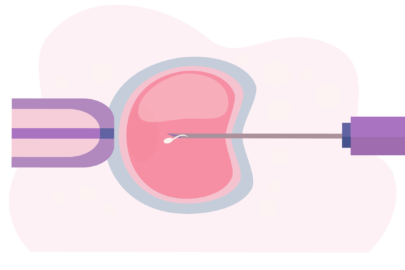
Understanding Infertility
Infertility could be defined as the inability or failure to conceive even after 12 months of regular sexual intercourse without the use of contraception. In women who are 35 years or older, this time period is shortened to 6 months. This is because fertility tends to gradually decline with age. There is a common assumption that fertility is a female health problem. However, this is not true. The male or the female or, in certain cases, both the partners may be responsible for infertility. Statistics indicate that in 40% of couples, infertility is caused by ‘female problems’; in another 40%, fertility issues are caused by ‘male problems’; and, in a meagre 10%, infertility is caused by problems in both. As far as the rest of the 10% is concerned, there is no obvious cause in either partner, and hence, it is known as ‘Unexplained infertility’. If the woman fails to conceive even after a year of regular unprotected sexual intercourse, the couple can conclude that either the wife or the husband, or both of them have fertility disorders.
Male Infertility: The causes
Generally, the male ejaculates 4 to 6ml of semen during sexual intercourse. The sperm count or the quantity of sperm in a sample of semen plays an important role in determining infertility. Approximately 15-150 million sperms per ml is regarded normal. A sperm count, which is below 15 million per ml, suggests a low sperm count and could lead to infertility.
Normally, a sperm moves or swims in a forward direction and have a unique shape with a head, neck and tail.
Male infertility is usually evaluated using the following:
Medical History
To identify if there are any conditions which might negatively impact fertility of the male, a comprehensive study of the patient’s medical history is done. This will, in turn, help to ascertain any specific conditions such as:
- Endocrine disorders (Diabetes)
- Trauma from previous surgery
- Infectious diseases
- Genetic conditions
- Medications that could affect reproductive function
- Consumption of alcohol, nicotine, drugs etc.
- Excessive psychological stress
- Work environment (Exposure to chemical industry, contact with X-rays, excess heat etc.)
- Difficulty in sexual intercourse
Clinical Examination
The patient’s medical history is supported by a clinical examination of his external genital organs namely; the testes, the penis, the scrotum, the epididymis, the vas deference, the presence of varicoceles and tight foreskin (phimosis). It is the urologist who reviews the medical history and conducts the clinical examination.
Semen Analysis
A semen sample is produced by various methods such as masturbation, coitus interruptus, condom collection, epididymal extraction etc. The semen sample is analysed for:
- The quantity of sperms
- Their mobility
- Their physical appearance
- Morphology of Sperms
Additional Investigations
The following additional investigations are sometimes required if the medical history, clinical examination or semen analysis indicates any issues. The tests may include:
- Biochemical examination of semen
- Bacteriological testing
- Hormone analysis
- Chromosomal analysis
Female Infertility: The causes
There are several factors that are responsible for female infertility. This includes:
Ovulation disorders
Ovulation disorders are a prominent cause of infertility in couples. Ovulation disorders could mean either infrequent ovulation or no ovulation at all. These could be caused by improper regulation of reproductive hormones by the hypothalamus or the pituitary gland, or by disorders in the ovary itself.
Polycystic Ovary Syndrome: In Polycystic Ovary Syndrome (PCOS), certain complex changes take place in the hypothalamus, pituitary gland and ovaries, causing hormone imbalance, which further tends to affect ovulation. One of the most common causes of female infertility, PCOS is often linked with insulin resistance, obesity, abnormal growth of hair on the face or body, and acne.
Around 30-40% of women who suffer from infertility problems do not produce eggs. This condition is called Anovulation. Anovulation may be caused due to complete failure or imbalance in the production of hormones by the pituitary gland, which further prevents the stimulation of follicles and release of eggs.
Tubal infertility
When there is a block or damage in the fallopian tubes, it prevents the sperm from reaching the egg or interrupts the passage of the fertilized egg into the uterus. The blockage of fallopian tube could be due to various reasons such as sexually transmitted diseases, previous surgery in the abdomen or pelvis, infections after abortions, endometriosis or the abnormal shape of the fallopian tube itself.
Endometriosis
Endometriosis is a condition that happens when tissue that generally grows in the uterus, implants and develops in other locations. The surgical removal of this extra tissue growth could result in scarring, which may block the fallopian tube and prevents the egg and sperm from uniting. It could also severely affect the lining of the uterus, disrupt the process of implantation of the fertilized egg or even damage the sperm or egg.
Uterine or Cervical causes
Normally, the sperms move up from the vagina through the cervix to the uterus and finally to the fallopian tube to meet the egg. The cervical canal is extremely narrow and is contains mucus through which the sperms have to pass. If there are any problems in the structure of the cervix or the type and texture of the mucus, it can disrupt the movement of sperms to the uterus. Uterine or cervical problems are mostly caused by the growth of benign polyps or tumours in the uterus, endometriosis, uterine abnormalities or Cervical stenosis.
Anti-sperm secretions
If there is infection in the cervix, or antibodies are present in the mucus secreted, it results in the destruction of the sperms, thus causing infertility.
Disorders of the endocrine system
Certain disorders of the endocrine system such as diabetes, thyroid etc can cause infertility.
Emotional & psychological stress
Modern life style and habits often causes emotional and psychological stress in couples which have negative implications in the functioning of the reproductive systems of the couple. This could in turn result in infertility.
Unexplained infertility
In certain cases, even after extensive investigations, the disorder with either the wife or husband cannot be identified. This condition is called unexplained infertility. However, there is a possibility that the wife may become pregnant after sometime. It is to be noted that after two years, the chances for the couple to conceive may decrease significantly.



